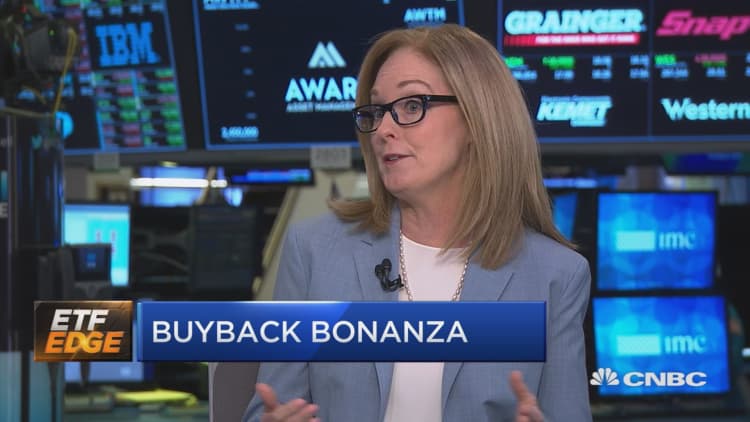U.S. companies are on pace to break another record for share repurchases in 2019, using a combination of cash and debt to push the total to close to $1 trillion.
For the first time since the financial crisis, companies have given back more to shareholders than they are making in cash net of capital expenditures and interest payments, or free cash flow, according to Goldman Sachs calculations.
The level of buybacks to free cash flow hit 104% for the 12 months ending in the first quarter of 2019, the first time that number has topped 100% during the economic recovery that started in 2009. In 2017, the level was 82%.

Goldman projects buybacks for S&P 500 companies to total $940 billion, a 13% increase over the previous year and a new high for a number that has continued to increase through much of the post-financial crisis period. Total buyback executions among all companies this year were up 26% through mid-July.
From a market perspective, investors have been moving to companies with more debt as they prepare for an expected interest rate cut later this week.
Burning cash, increasing debt
The buyback increase compares with a projected 8% gain in capital expenditures and 9% for research and development this year.
The rise in buybacks has had a twin effect on corporate balance sheets, both drawing down cash and increasing leverage. It also represents a more-of-the-same trend that has come despite the $1.5 trillion tax cut passed in late 2017. The record cut had spurred hopes that companies would eschew the buyback formula that has helped generate the longest bull market run in Wall Street history and instead lead to more investment in equipment and personnel.
"Although we expect growth in capex, R&D, and cash M&A, we expect companies will continue to increase cash return to shareholders as they have in recent years," David Kostin, chief U.S. equity strategist at Goldman, said in a report for clients.
Over the past 12 months, nonfinancial companies have drained $272 billion in cash as part of the push to return still more money to shareholders. That represents a 15% decline and is the steepest drop since at least 1980, Kostin said.
At the same time, corporate leverage continues to rise as gross debt outstanding has climbed 8% over the past 12 months. That has come during a rough time for corporate profits, with S&P 500 earnings tracking for a 2.6% second-quarter decline, according to FactSet.
"Unless earnings growth accelerates materially, companies will likely continue to fund spending by drawing down cash balances and increasing leverage," Kostin wrote.
As the Federal Reserve had been raising rates since 2015, Goldman touted companies with strong balance sheets over those with heavy debt-to-earnings levels. That's a trade that worked well from the start of 2017 until the end of 2018, with former returning 21% vs. a 3% loss for the latter, but that's reversed lately.
But with the Fed about to cut, the trend has reversed. Since the start of June, weaker balance sheet companies have seen a return of 12% vs. 8% for their counterparts in anticipation that the cost of borrowing will get even cheaper.
At a company level, Goldman's list of weak balance sheet companies include AT&T, GM, Automatic Data Processing, Kraft Heinz and Delta Air Lines. Some of the bigger names on the strong balance sheet side include Alphabet, Costco, Mastercard, Facebook and Intuitive Surgical.


